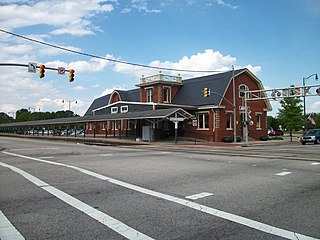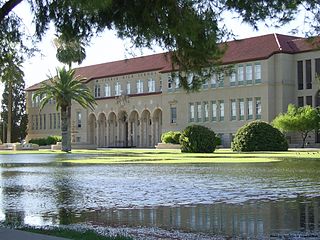
Darlington is a city located in Darlington County, South Carolina, United States. In 2010, its population was 6,289. It is the county seat of Darlington County. It is part of the Florence, South Carolina Metropolitan Statistical Area.

Florence is a city in and the county seat of Florence County, South Carolina, United States. It lies at the intersection of Interstates 20 and 95 and is the eastern terminus of the former. It is the primary city within the Florence metropolitan area. The area forms the core of the historical Pee Dee region of South Carolina, which includes the eight counties of northeastern South Carolina, along with sections of southeastern North Carolina. As of the 2020 census, the population of the city was 39,899, making it the 10th-most populous city in the state.
The Pee Dee is a region in the northeast corner of the U.S. state of South Carolina. It lies along the lower watershed of the Pee Dee River, which was named after the Pee Dee, an Indigenous tribe historically inhabiting the region.

Fayetteville station is an Amtrak train station in Fayetteville, North Carolina, United States. It is located in the Fayetteville Downtown Historic District, next to the Airborne & Special Operations Museum.

The Goldsboro Union Station is a former passenger train depot and future intermodal transit station in Goldsboro, North Carolina, United States. Originally operating from 1909 to 1968, the Eclectic two-story brick depot was preserved as one of the most ambitious railroad structures in North Carolina, built as a symbol of the importance of railroading to Goldsboro. Currently closed-off for future renovations, the five-acre (2.0 ha) facility also includes the GWTA Bus Transfer Center.
William Augustus Edwards, also known as William A. Edwards was an Atlanta-based American architect renowned for the educational buildings, courthouses and other public and private buildings that he designed in Florida, Georgia and his native South Carolina. More than 25 of his works have been listed on the National Register of Historic Places.

Frank Pierce Milburn was a prolific American architect of the late 19th and early 20th centuries. His practice was primarily focused on public buildings, particularly courthouses and legislative buildings, although he also designed railroad stations, commercial buildings, schools and residences. Milburn was a native of Bowling Green, Kentucky who practiced as an architect in Louisville from 1884 to 1889; Kenova, West Virginia 1890–1895; Charlotte, North Carolina; Columbia, South Carolina; and Washington, D.C. after 1904. From 1902 Milburn was architect for the Southern Railway.

Lescher & Mahoney was an American architectural firm from Phoenix, Arizona.
The Cheraw and Darlington Railroad was a 26-mile (42 km) 5 ft gauge shortline railroad that served South Carolina and, later, North Carolina, beginning before the American Civil War. The gauge was changed to 4 ft 9 in in 1886.

Charles C. Wilson was an American architect in practice in Columbia, South Carolina, from 1896 until his death in 1933.

Joseph Florence Leitner was an American architect whose work includes several rail stations. In Columbia, South Carolina he worked for Charles Coker Wilson for five years. Later he partnered with William J. Wilkins (architect), first in Florence, South Carolina and then in an office in Wilmington, North Carolina, where Leitner practiced for a decade. to form Leitner & Wilkins. His work included commercial, educational, fraternal religious, industrial, residential, and transportation buildings in colonial revival architecture, Flemish architecture (especially gables, Italianate architecture and Romanesque revival architecture styles. He ended his career in Florida.
James Mackson McMichael, known as James M. McMichael, was an American architect. Several buildings he designed are listed on the National Register of Historic Places.
Leslie N. Boney Sr. (1880–1964) was an American architect who focused on schools. He designed approximately 1,000 schools or additions to schools, and his works appear in 51 of North Carolina's 100 counties.

Poynor School is a historic school building constructed from 1906 to 1908 in Florence, South Carolina. It was designed by local architect William J. Wilkins and was the contractor's first commission as an architect. Now known as Poynor Junior High School, it is located at 301 South Dargan Street and is listed on the National Register of Historic Places.

The Robert Smalls School is a historic school building at 316 Front Street in Cheraw, South Carolina. This single story brick Colonial Revival structure was designed by the Florence firm of Hopkins, Baker & Gill, and completed in 1953. It was part of a development effort by the city to modernize its schools while continuing to provide "separate but equal" education facilities for its African-American citizenry. It served as a public school until the 1990s, and was sold by the city to a nonprofit organization in 2012. It now houses a food pantry and services for at-risk youth. It was named for Robert Smalls.
Willard Close Northup (1882–1942) was an American architect in North Carolina who was the principal partner in the firm Northup & O'Brien. His firm was based in Winston-Salem, North Carolina. Northup began his architectural practice in 1906 and partnered with Leet Alexander O'Brien (1891–1963) in 1915 or 1916. Luther Lashmit joined the firm in 1927, and was lead architect for Graylyn while an employee of the firm.
Charles (Charlie) Hussey Boney was an American architect.
James F. Post was an architect, builder, and contractor who designed and oversaw the construction of over 60 buildings. He is most known for his buildings in Wilmington, North Carolina, including the Bellamy Mansion, New Hanover County Courthouse, City Hall-Thalian Hall, and Zebulon Latimer House.

Witt, Seibert & Halsey was an American architectural firm based in the twin cities of Texarkana, Arkansas and Texarkana, Texas, with a practice extending into Arkansas, Louisiana and Texas. It was founded by architect Sidney Stewart, but achieved prominence under Bayard Witt and Eugene C. Seibert.

Wilmington Union Station was a union station in Wilmington, North Carolina. Opened in 1913, it was designed by architect Joseph F. Leitner. Construction by Boyle-Robertson contractors began in 1912. It was located at Front Street and Red Cross Street in downtown Wilmington.












